Security in Public Areas: New Threats Require New Responses
Increasingly aggressive, religiously motivated terrorism, the increase in vandalism, sabotage and organised crime continuously make new or extended security concepts necessary. Unt...



Increasingly aggressive, religiously motivated terrorism, the increase in vandalism, sabotage and organised crime continuously make new or extended security concepts necessary. Until now, high security products and systems for fence detection and outdoor monitoring have been used predominantly in prisons or forensics, embassies, military sites, nuclear power plants, airports or other critical infrastructures. But the demands placed on security concepts continue to rise in all areas. An article by Kira Lichte, Marketing PPG.
How the requirements and complexity of security products and concepts can change is exemplified by the increasing importance of certifications. These include, for example, the requirement for a ‚known sender‘ in the logistics industry or the Food V6 certification for food manufacturers, but also the ISO/TS 16949 currently being updated that improves standards in the automotive industry. Amongst other things, this requires automotive suppliers to carry out audits to increase the requirements of safety-relevant components and procedures or to improve the source tracing capability of products.
Inner Cities and Public Places
The hot topic right now in the security industry is strengthening the protection of inner-city areas and public places. The very controversial law package presented by Thomas de Maizière, the German Federal Minister of the Interior, after the amok run in Munich, the attack in Ansbach and more recently on the Berlin Christmas market at Breitscheidplatz, anticipates an expansion of video surveillance of highly frequented public places such as shopping centers – after corresponding amendment of the Data Protection Act in the sense of increased security. The Federal Data Protection Act is to be replaced by the EU Data Protection Code by May 2018. Political opponents of this package, such as Frank Tempel, member of the German parliament and the left wing in Germany considers it to be senseless. On Berlin Brandenburg radio he spoke of “placebos for the subjective feeling of security“ because potential perpetrators could simply adapt themselves to video surveillance and act accordingly.
Video Helps with Perpetrator Identification
In practice, video surveillance serves to verify facts more easily, as recently demonstrated by the case of the ‘Berlin metro kicker‘. After publication of the surveillance video, a companion of the perpetrator was quickly identified. The video spread rapidly in the Internet and in social networks and, shortly afterwards, the police could establish the identity of the alleged perpetrator and arrest him. Definitely a success, but not effective or preventative protection!
The instrumentalisation of vehicles for attacks by the so-called IS is a threat that cannot be countered solely by increased video surveillance. Konstantin von Notz, a politician from the German green party, told a Berlin newspaper: “A thousand cameras at Breitscheidplatz would not have prevented this terrible attack“. Furthermore, the cost-effectiveness of a pure video surveillance system is debatable since constant monitoring is necessary by trained personnel to verify real emergencies and initiate an intervention by the law enforcement agencies or to exclude false alarms.
Combinations Fashionable Again
For this reason, the trend of combining different security techniques definitely makes sense. The selection of a ‘matching system‘ and the optimum combination depends on various criteria. In addition to the level of protection, the offenders profile and the type of possible threat, also the contours and texture of a building or terrain are influential factors. Securing inner-city areas is challenging due to the fact that they are partly very close to buildings or are subject to fundamental restrictions due to underground cables and pipelines, or because of heavy traffic or many people. Another significant consideration is the visual appearance of a security system in public areas. Visually deterrent concepts are not wanted here as they create a feeling of constantly present threats and ultimately create further fear. Berlin has responded to the attack with a stronger police-presence and heavy concrete blocks as short-term solution.
However, in the long term, it is important to have modern, preventatively working security solutions that can be integrated into the environment in a discreet but effective way. Michael Luckey, PPG sales manager says: “The keyword is prevention! I am of the opinion that high security products that resist impact loads are an ideal and preventive complement to the protection of pedestrian zones or other public areas that can be reached by vehicles on access roads. Crash-tested movable bollards, such as those from PPG for example, are not really noticed in the lowered position, and can be easily crossed without hindering traffic. In case of emergency, they block roadways or entire areas effectively – even against heavy vehicles such as trucks – by rising out of the ground within seconds. Fixed bollards are also suitable for permanently secured areas.
The effective impact load of such products is documented by international crash test certifications, which are granted after successful tests under real conditions. Depending on the standard, vehicles with a speed of up to 80 kph (up to 7.5 tonnes) bounce onto the bollard systems and come to an immediate standstill. PPG has been carrying out such tests for about 30 years and they ensure the mandatory security of high security products.“
Barriers and Crash Gates
He adds: “The PPG range includes further impact-tested products, such as wedge barriers, crash gates and bollards, certified according to the PAS 68, ASTM and IWA 14-1 international standards. The elkosta Wedge II needs a flat foundation of only 200 mm plus 100 mm road covering. With its decreased installation depth and foundation footprint, the Wedge II reduces installation costs significantly and permits usage in areas where foundation depths are limited due to underground utilities.“ It is clear that a long-term security solution that can be implemented quickly and easily in many places must be found in the short term.
It is clear that, ultimately, only a complete, consistent security concept that ensures secure shielding with a sufficient distance to the respective perimeter can really protect in case of emergency. Michael Luckey concludes: “Comprehensive perimeter protection in public areas can only be created by a combination of mechanical and electronic components. Depending on the type of perimeter, this should include exterior protection with crash bollards or other certified, impact-tested barriers, vehicle sluices with quick folding gates or a barrier/sliding gate combination if necessary, entrance and access control systems for pedestrians as well as additional video monitoring. For places like the Berlin Breitscheidplatz, however, crash bollards are definitely in the forefront since these ensure that an unauthorized vehicle is effectively stopped before even reaching such an area.
Business Partner
Perimeter Protection Germany GmbHJohann-Reineke-Straße 6-10
33154 Salzkotten
Germany
most read

Assa Abloy's battery-powered Aperio KL100 secures lockers
Boost workplace security and operational flexibility by securing more than just doors.

Integrated and Futureproof: Traka’s Next Chapter
Interview with Stefni Oliver on Traka’s Vision for the Future

VIP-Lounge Interview: Marco Mille, Global Head of Security, Siemens AG
VIP in the World of Security: Marco Mille, Global Head of Security at Siemens AG

Security management, building security & perimeter protection: the winners of category E at the GIT SECURITY AWARD 2026
GIT SECURITY AWARD 2026: Security management, building security & perimeter protection - an overview of the most innovative solutions

What Does Ethical AI Governance Look Like in Practice?
The InCyber Briefing will explore AI, post-quantum readiness, data sovereignty, and crisis simulation








